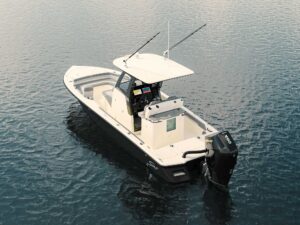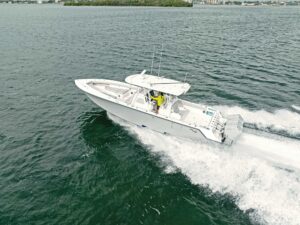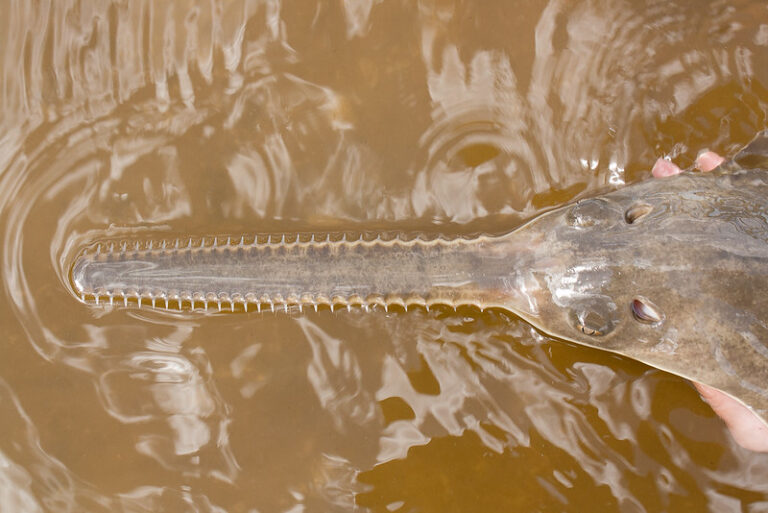Much more than a big stick with which to push yourself around, modern-day push poles use Space Age materials to achieve incredibly light weights, strength and durability. Along with all the advances comes one glaring pitfall: The proliferation of manufacturers and the number of different styles and options make finding the right pole for your style of fishing and experience level a real challenge.
At the same time, picking a push pole is much like shopping for a good pair of shoes: You can’t let someone else pick ’em out. You just have to try ’em on yourself.
The Pros Like Them Stiff
One of the most important factors to consider when buying a push pole, and the most difficult to measure, is its stiffness. Since poles vary in diameter as well as composition and construction methods, few hard and fast rules govern how stiff a particular pole might be. Relying on a manufacturer’s designation might leave you with a pole that doesn’t fit your definition of “stiff.” Generally speaking, however, most fiberglass poles and graphite/glass composites won’t be as stiff or as light as one made of solid graphite.
All of the professional guides I talked to prefer a very stiff pole, but they don’t necessarily recommend the same for the average fisherman. Stiffer poles provide more power, but at the same time their lack of flexibility makes them less manageable for the inexperienced. _Capt. Jorge Valverde_, who fishes Florida and Biscayne bays, says that using a stiffer pole requires more time spent on the water. “When you’ve poled for a while, you learn to plan every move in advance. You set up drifts and learn to work with the wind rather than fight it. People who haven’t poled a lot need a more flexible and forgiving pole for ease of correction once they get themselves in a jam. A pole with some bend allows you to make subtle adjustments without having to pick up and reposition the pole.”
Capt. Joe Weirback, a guide in the Ten Thousand Islands area of southwest Florida, likes them stiff as well: “A stiff pole that doesn’t bend gives you more power and allows you to turn a bit faster because you don’t have to wait for the pole to flex out.”
Points and Feet
Flats fishermen encounter all types of bottom, ranging from hard coral to near-liquid mud. That’s why most poles have a point on one end and a foot on the other. You usually use the point end, called an oyster tip, when poling over hard bottom and the foot end over soft bottom or mud.
Oyster tips come in two basic styles: a regular cone-shaped style made out of aluminum, plastic or fiberglass, and the “trash-picker” style that features a cone-shaped body with a metal tip that protrudes from the end of the cone. Metal points can cause some noise scratching on the bottom, but sometimes they’re the only option when you’re over a hard surface. “The trash-picker tip is used on very hard bottom, like smooth coral, where you can’t use the foot because of slippage,” says Valverde.
Feet come in three basics styles but are made from a variety of different materials. The Y-shaped foot features two prongs or forks extending from the end of the pole, while the delta-shaped foot looks like a triangular blade. The third style is a hybrid of the two, featuring a small blade with two prongs at each corner made exclusively by Biscayne Rods.
Whichever style point or foot you choose, Chris Dwyer, president of High Tech Innovations, says you should stay away from aluminum hardware. “Aluminum is cheap and strong, but after a while it will oxidize,” Dwyer says. “Maybe not after one season, but it will happen eventually. Choose a pole with Delrin, nylon or ABS plastic hardware.”
Below are a few guidelines and instructions to be aware of when buying and using your new pole. As with every piece of equipment, there are trade-offs to consider when picking different features.
** Color** Some guides prefer black or dark colors because they feel that lighter-colored poles will spook fish. On the other hand, other guides claim that black poles heat up in the sun to palm-scorching temperatures.
** Length** You should use the water depth at which you normally fish, not the length of your boat, to determine the length of your push pole. If you’re going to be fishing in canals or on deeper flats from a poling platform, go long. However, recognize that a long pole can interfere with fly fishermen on their backcasts.
** Diameter** Make sure the pole fits comfortably in your hands. If you have large hands, a small-diameter pole will fatigue your hands faster, resulting in finger cramps.
Grip Graphite poles usually feature a surface much slicker than fiberglass. If you find your hands slipping, wet them; it should improve your grip. Leather gloves can also provide a firmer grip.
Stake-out poles The majority of push-pole breakages occur when you’re staking out. It’s a good idea to bring along a short 6- to 8-foot stake-out pole to spare your main pole the strain. Plus, if you break the stake-out pole, you’re not out $200 to $400.









